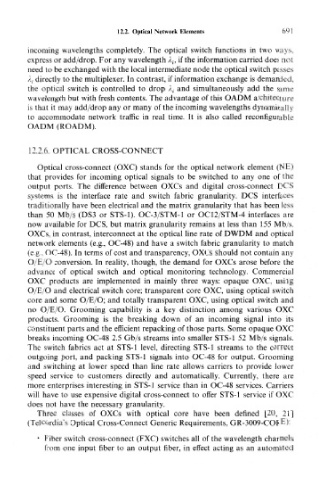Page 707 - Introduction to Information Optics
P. 707
12.2. Optical Network Elements 691
incoming wavelengths completely. The optical switch functions in two ways,
express or add/drop. For any wavelength A ;, if the information carried does not
need to be exchanged with the local intermediate node the optical switch passes
/, directly to the multiplexer. In contrast, if information exchange is demanded,
the optical switch is controlled to drop A t and simultaneously add the same
wavelength but with fresh contents. The advantage of this OADM architecture
is that it may add/drop any or many of the incoming wavelengths dynamically
to accommodate network traffic in real time. It is also called reconfigurable
OADM (ROADM).
12.2.6. OPTICAL CROSS-CONNECT
Optical cross-connect (OXC) stands for the optical network element (NE)
that provides for incoming optical signals to be switched to any one of the
output ports. The difference between OXCs and digital cross-connect DCS
systems is the interface rate and switch fabric granularity. DCS interfaces
traditionally have been electrical and the matrix granularity that has been less
than 50 Mb/s (DS3 or STS-1). OC-3/STM-1 or OC12/STM-4 interfaces are
now available for DCS, but matrix granularity remains at less than 155 Mb/s.
OXCs, in contrast, interconnect at the optical line rate of DWDM and optical
network elements (e.g., OC-48) and have a switch fabric granularity to match
(e.g., OC-48). In terms of cost and transparency, OXCs should not contain any
O/E/O conversion. In reality, though, the demand for OXCs arose before the
advance of optical switch and optical monitoring technology. Commercial
OXC products are implemented in mainly three ways: opaque OXC, using
O/E/O and electrical switch core; transparent core OXC, using optical switch
core and some O/E/O; and totally transparent OXC, using optical switch and
no O/E/O. Grooming capability is a key distinction among various OXC
products. Grooming is the breaking down of an incoming signal into its
constituent parts and the efficient repacking of those parts. Some opaque OXC
breaks incoming OC-48 2.5 Gb/s streams into smaller STS-1 52 Mb/s signals.
The switch fabrics act at STS-1 level, directing STS-1 streams to the correct
outgoing port, and packing STS-1 signals into OC-48 for output. Grooming
and switching at lower speed than line rate allows carriers to provide lower
speed service to customers directly and automatically. Currently, there are
more enterprises interesting in STS-1 service than in OC-48 services. Carriers
will have to use expensive digital cross-connect to offer STS-1 service if OXC
does not have the necessary granularity.
Three classes of OXCs with optical core have been defined [20, 21]
(Telcordia's Optical Cross-Connect Generic Requirements, GR-3009-CORE);
* Fiber switch cross-connect (FXC) switches all of the wavelength channels
from one input fiber to an output fiber, in effect acting as an automated

